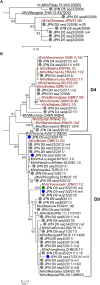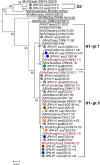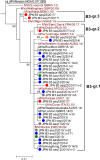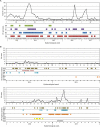Nationwide Molecular Epidemiology of Measles Virus in Japan Between 2008 and 2017
- PMID: 31333607
- PMCID: PMC6620789
- DOI: 10.3389/fmicb.2019.01470
Nationwide Molecular Epidemiology of Measles Virus in Japan Between 2008 and 2017
Abstract
Genotyping evidence that supports the interruption of endemic measles virus (MV) transmission is one of the essential criteria to be verified in achieving measles elimination. In Japan since 2014, MV genotype analyses have been performed for most of the measles cases in prefectural public health institutes nationwide. With this strong molecular epidemiological data, Japan was verified to have eliminated measles in March, 2015. However, even in the postelimination era, sporadic cases and small outbreaks of measles have been detected repeatedly in Japan. This study investigated the nationwide molecular epidemiology of MV between 2008 and 2017. The 891 strains in the total period between 2008 and 2017 belonged to seven genotypes (D5, D4, D9, H1, G3, B3, and D8) and 124 different MV sequence variants, based on the 450-nucleotide sequence region of the N gene (N450). The 311 MV strains in the postelimination era between 2015 and 2017 were classified into 1, 7, 8, and 32 different N450 sequence variants in D9, H1, B3, and D8 genotypes, respectively. Analysis of the detection period of the individual N450 sequence variants showed that the majority of MV strains were detected only for a short period. However, MV strains, MVs/Osaka.JPN/29.15/ [D8] and MVi/Hulu Langat.MYS/26.11/ [D8], which are named strains designated by World Health Organization (WHO), have been detected in many cases over 2 or 3 years between 2015 and 2017. The WHO-named strains have circulated worldwide, causing outbreaks in many countries. Epidemiological investigation revealed repeated importation of these WHO-named strains into Japan. To demonstrate the elimination status (interruption of endemic transmission) in situations with repeated importation of the same strains is challenging. Nevertheless, the detailed sequence analysis of individual MV strains and chronological analysis of these strains provided sufficient evidence to show that Japan has still maintained its measles elimination status in 2017.
Keywords: Japan; elimination; genotype; measles virus; molecular epidemiology.
Figures





References
-
- Aoki Y., Mizuta K., Suto A., Ikeda T., Abiko C., Yamaguchi I., et al. (2009). Importation of the evolving measles virus genotype d9 to yamagata, Japan from Thailand in 2009. Jpn. J. Infect. Dis. 62 481–482. - PubMed
LinkOut - more resources
Full Text Sources

